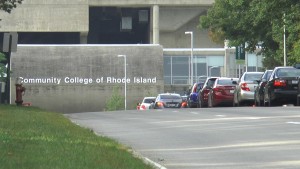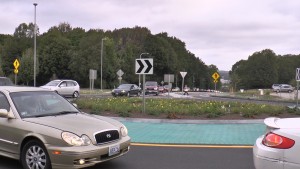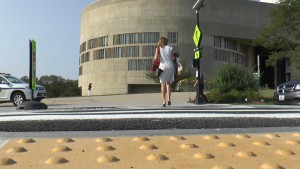 Anyone who has visited CCRI’s Warwick campus in the morning knows the drill: A line of cars backed up on the long road in from East Avenue, and controlled chaos as hundreds of people arrive in a short period of time.
Anyone who has visited CCRI’s Warwick campus in the morning knows the drill: A line of cars backed up on the long road in from East Avenue, and controlled chaos as hundreds of people arrive in a short period of time.
But students, faculty and staff arriving for the first day of classes this year not only got a big welcome on the sign leading into campus, but also a new traffic pattern that is making a comeback in some parts of Rhode Island: The roundabout, or rotary, which the administration hopes will reduce some of the confusion and congestion that has plagued the campus in years past. The rotary is designed to both slow down and keep the traffic moving.
“We had a lot of cars going in a lot of different directions, and a lot of people trying to get into the building, without a tremendous amount of direction,” said college spokesman Patrick Stone. The rotary and associated improvements cost $1.8 million and include landscaping, a modified speed bump and better signage for a crosswalk from the faculty parking lot. They are part of a five-year plan to give the aging campus a face-lift.
 It’s the rotary — and particularly the speed bump — that has drawn the most reaction. And it has been a mixed reaction from the students, faculty and staff we spoke with over the first week of school.
It’s the rotary — and particularly the speed bump — that has drawn the most reaction. And it has been a mixed reaction from the students, faculty and staff we spoke with over the first week of school.
“I’ve been here before; the traffic pattern sucks,” said student Malcom DePina of Providence. “I blame the roundabout. I think the roundabout hurts because it’s slower to get in.”
Jean-Luc Gonzalez agreed: “It’s mainly because the roundabout’s so slow because no one knows how to yield at times. That entire line that goes back onto that little intersection is always backed up and it’s a pain.”
Others, though, thought it was an improvement. “I think I kind of like it; it’s easier for passengers to move around,” said Ibraheim Shode.
One the of the biggest changes is a closure of the road that goes under the main building. It is now totally blocked off to motor vehicles, with handicapped parking accessible in the back, forcing drivers to go around the building to get there.
“I think speed, and again, public safety is the heart of this entire project, really slowing everything down a little bit,” said Stone, the college spokesman. “We had a lot of fast cars and people running into the college, and kids trying to scramble to get to their classes and everybody was go, go, go.”
 Several faculty members approached us complaining privately about the new traffic pattern. Students, though, had no problem talking publicly about a speed bump they say is both higher and longer than it was last year.
Several faculty members approached us complaining privately about the new traffic pattern. Students, though, had no problem talking publicly about a speed bump they say is both higher and longer than it was last year.
Stone countered: “I think the reasoning for that speed bump, primarily, is that’s a really high traffic [area] for pedestrians. That’s where our faculty and staff walk in — a lot of the people coming off the bus will walk over that way to go up that second-floor ramp. We really wanted to make sure that was as slow as possible.”
Others told us the lines were so long because the rotary slowed the traffic down, then motorists faced another slow-down with the speed bump, defeating the purpose of the rotary: to keep things moving slowly, but steadily.
In addition to the rotary, the college renovated the Great Hall inside and has plans to replace the long, main pedestrian ramp leading up from the parking lot, an original structure that is clearly showing its age.
Just as there has been a steep learning curve with the state’s Apponaug Circulator project not too far from CCRI, the college says it may take a little while for those arriving here to get used to the new pattern.
On the Friday before classes began, CCRI sent out a mass email, outlining the new traffic pattern and preaching patience during the transition period. Student Nick Wainwright agrees there will be a learning curve. “It’s kind of confusing; I ran into a couple of problems this morning. People don’t know how to yield. Classic Rhode Island.”
Stone is preaching patience: “I think there’s people who are going into this and they’ve never seen a rotary, there’s not that many in Rhode Island. It’s becoming a more popular aspect, I think, of traffic engineering to bring it back, especially in these areas where it wasn’t necessarily the safest it could have been before, when you have a lot of fast traffic. So I’m sure it is new to people and like I said, that first day even to now people are getting used to it.”
The Hummel Report is a 501 3C non-profit organization that relies, in part, on your donations. If you have a story idea or want make a donation go to HummelReport.org, where you can also see the video version of this story. You can mail Jim directly at Jim@HummelReport.org